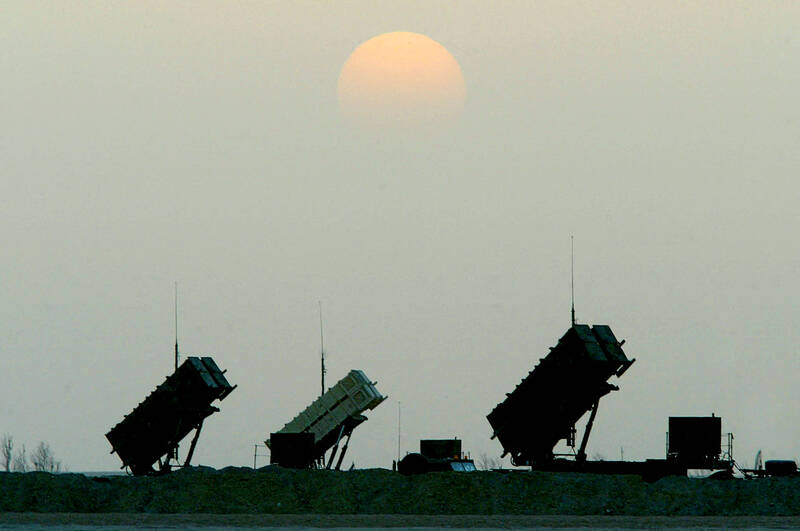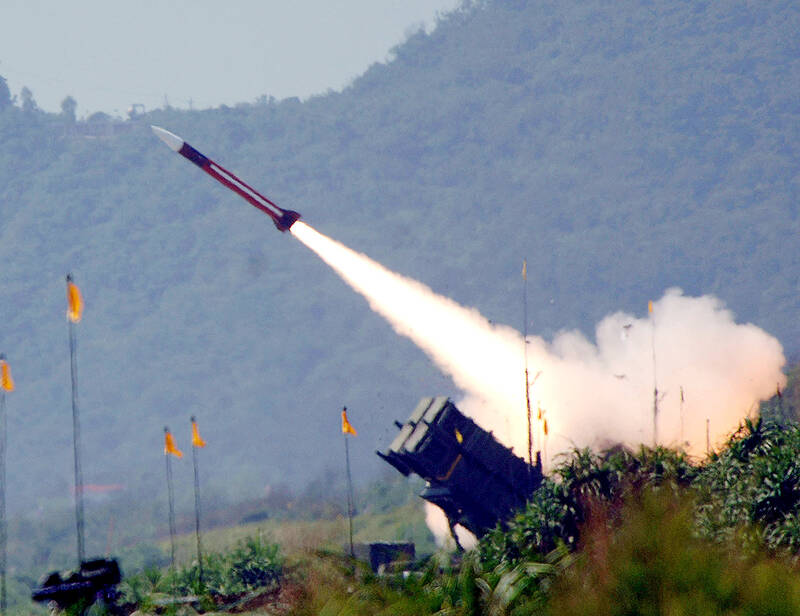Patriot missile systems have long been a hot ticket item for the US and allies in contested areas of the world as a coveted shield against incoming missiles. In Europe, the Middle East and the Pacific, they guard against potential strikes from Iran, Somalia and North Korea.
So it was a critical turning point when news broke this week that the US has agreed to send a Patriot missile battery to Ukraine — something Ukrainian President Volodymyr Zelenskyy has sought for months to augment his country’s air defenses. US officials have confirmed the agreement, and an official announcement is expected soon. But experts caution that the system’s effectiveness is limited, and it may not be a game changer in the war.
A look at what the system is and what it does:

Photo: AFP
WHAT IS THE PATRIOT?
The Patriot is a surface-to-air guided missile system that was first deployed in the 1980s and can target aircraft, cruise missiles and shorter-range ballistic missiles.
Each Patriot battery consists of a truck-mounted launching system with eight launchers that can hold up to four missile interceptors each, a ground radar, a control station and a generator. The Army said it currently has 16 Patriot battalions. A 2018 International Institute for Strategic Studies report found those battalions operate 50 batteries, which have more than 1,200 missile interceptors.

Photo: AFP
The US batteries are regularly deployed around the world. In addition, Patriots also are operated or being purchased by the Netherlands, Germany, Japan, Israel, Saudi Arabia, Kuwait, Taiwan, Greece, Spain, South Korea, the United Arab Emirates, Qatar, Romania, Sweden, Poland and Bahrain.
The Patriot system “is one of the most widely operated and reliable and proven air missile defense systems out there,” and the theater ballistic missile defense capability could help defend Ukraine against Iranian-supplied ballistic missiles, said Tom Karako, director of the Missile Defense Project at the Center for Strategic and International Studies.
PATRIOT COST
Over the years the Patriot system and missiles have been continually modified. The current interceptor missile for the Patriot system costs approximately US$4 million per round and the launchers cost about US$10 million each, CSIS reported in its July missile defense report. At that price, it’s not cost effective or optimal to use the Patriot to shoot down the far smaller and dramatically cheaper Iranian drones that Russia has been buying and using in Ukraine.
“Firing a million-dollar missile at a US$50,000 drone is a losing proposition,” said Mark Cancian, a retired Marine Corps reserves colonel and senior adviser at CSIS.
DEPLOYMENT CONCERNS
A Patriot battery can need as many as 90 troops to operate and maintain it, and for months the US was reluctant to provide the complex system because sending forces into Ukraine to operate it is a non-starter for the Biden administration.
But there were also concerns that deployment of the system would provoke Russia, or risk that a missile fired could end up hitting inside Russia, which could further escalate the conflict.
On Thursday, Russia’s Foreign Ministry warned that a US plan to deliver sophisticated air defense missiles to Ukraine would be “another provocative move by the US” that could prompt a response from Moscow.
According to officials, the urgent pleadings of Ukrainian leaders and the devastating destruction of the country’s civilian infrastructure, including loss of electricity and heat as winter drags on, ultimately overcame US reservations about supplying the Patriots.
A key hurdle will be training. US troops will have to train Ukrainian forces on how to use and maintain the system. Army solders assigned to Patriot battalions get extensive training to be able to effectively locate a target, lock on with radar and fire.
The US has trained Ukrainian troops on other complex weapons systems, including the High Mobility Artillery Rocket Systems, known as HIMARS. In many cases they’ve been able to shorten the training, getting Ukrainian troops out to the battlefront in weeks. Officials have declined to provide details on how long the Patriots training would take and where exactly it will be done.
PATRIOT CAPABILITIES
Ukraine faces a range of Russian threats, and the Patriot is good against some and not that useful against others.
One former senior military official with knowledge of the Patriot system said it will be effective against short-range ballistic missiles and it represents a strong message of US support, but one battery isn’t going to change the course of the war.
The official, who spoke on condition of anonymity because the Ukraine deal has not yet been made public, noted that one Patriot battery has a long firing range, but can cover only a limited broad area. As an example, Patriots can effectively protect a small military base, but can’t fully protect a large city such as Kyiv. They could only provide coverage for a segment of a city.
Patriots are often deployed as a battalion, which includes four batteries. This won’t be the case with Ukraine, which officials said would be receiving one battery.
The Patriot has a more powerful radar that is better at discriminating targets than the Soviet-era S-300 system the Ukrainians have been using, but it has limitations, both Karako and Cancian said.
Still the Patriot’s ability to target some ballistic missiles and aircraft could potentially protect Kyiv if Russian President Vladimir Putin carried through on his persistent threat to deploy a tactical nuclear device. But that would depend on how the weapon was delivered, Karako said. If it was a gravity bomb delivered by a warplane, the system could target the aircraft; if it was a cruise or short-to-medium-range ballistic missile, it could also possibly intercept the missile, Karako said.
Raytheon, which manufactures the Patriot, says it has been involved in 150 intercepts of ballistic missiles since 2015. The success rate of the Patriot, however, has been repeatedly questioned. A 1992 Government Accountability Office report said it could not find evidence to support reports that the system had achieved a 70 percent success rate against Scud missiles in the Gulf War. In 2018, Saudi Arabia’s success in using Patriots against missiles fired by Houthi rebels in Yemen was questioned when videos surfaced of systems failing.
But beyond the Patriot’s capabilities, its deployment is a big statement of support for Ukraine.
“There’s a lot of symbolism here,” Cancian said.
Note to readers:The View from Central Taiwan will return to these pages on Monday next week.

A vaccine to fight dementia? It turns out there may already be one — shots that prevent painful shingles also appear to protect aging brains. A new study found shingles vaccination cut older adults’ risk of developing dementia over the next seven years by 20 percent. The research, published Wednesday in the journal Nature, is part of growing understanding about how many factors influence brain health as we age — and what we can do about it. “It’s a very robust finding,” said lead researcher Pascal Geldsetzer of Stanford University. And “women seem to benefit more,” important as they’re at higher risk of

Eric Finkelstein is a world record junkie. The American’s Guinness World Records include the largest flag mosaic made from table tennis balls, the longest table tennis serve and eating at the most Michelin-starred restaurants in 24 hours in New York. Many would probably share the opinion of Finkelstein’s sister when talking about his records: “You’re a lunatic.” But that’s not stopping him from his next big feat, and this time he is teaming up with his wife, Taiwanese native Jackie Cheng (鄭佳祺): visit and purchase a

Last week the Democratic Progressive Party (DPP) said that the budget cuts voted for by the China-aligned parties in the legislature, are intended to force the DPP to hike electricity rates. The public would then blame it for the rate hike. It’s fairly clear that the first part of that is correct. Slashing the budget of state-run Taiwan Power Co (Taipower, 台電) is a move intended to cause discontent with the DPP when electricity rates go up. Taipower’s debt, NT$422.9 billion (US$12.78 billion), is one of the numerous permanent crises created by the nation’s construction-industrial state and the developmentalist mentality it

Experts say that the devastating earthquake in Myanmar on Friday was likely the strongest to hit the country in decades, with disaster modeling suggesting thousands could be dead. Automatic assessments from the US Geological Survey (USGS) said the shallow 7.7-magnitude quake northwest of the central Myanmar city of Sagaing triggered a red alert for shaking-related fatalities and economic losses. “High casualties and extensive damage are probable and the disaster is likely widespread,” it said, locating the epicentre near the central Myanmar city of Mandalay, home to more than a million people. Myanmar’s ruling junta said on Saturday morning that the number killed had